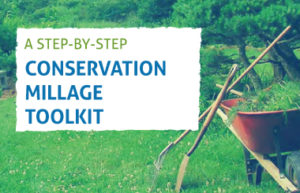Report Illegal Dumping and Pollution Emergencies
Report a Water Pollution Emergency
Dumping waste into storm drains, ditches or waterways contaminates drinking water supplies, recreational areas, and wildlife habitat.
Plus, it is ILLEGAL!
Cleanup efforts cost millions of tax dollars each year.
If you see illegal dumping, report it right away. You will help prevent further water contamination and reduce potential clean up costs.
To report illegal dumping call:
- EGLE’s 24 Hour Pollution Emergency Alert System 800-292-4706
- For hazardous or flammable spills call 9-1-1 immediately.
If the situation is not an emergency, HRWC can help you find the proper contact in the state or local government. Please email us with these concerns.
Boating and Fishing
Halt the Spread of Invasive Aquatic Species
It’s important to know how to identify and prevent invasive species from spreading. Invasive species are not native to the region and flourish without a natural predator or other means of natural balance. These invasive species spread quickly and exhaust resources used by native species, crowding them out.
Aquatic invasive species include plants and animals. Most commonly known are zebra mussels, the sea lamprey, round gobies, eurasion milfoil, phragmites, and the asian carp.
In a region like Southeast Michigan with its many lakes and streams, there are lots of opportunities for aquatic invasives to spread. Proper lake and stream management as well as maintenance of boating equipment can help.
IDENTIFYING INVASIVE SPECIES
Assist experts with finding invasives in the field but DO NOT PULL INVASIVE AQUATIC PLANT SPECIES out of infested areas. This can actually help spread the plant’s seeds or its fragments which can root elsewhere.
Check the Midwest Invasive Species Information Network (MISIN) for an up-to-date list of invasive species and how to identify them. MISIN is a regional effort to develop and provide an early detection and rapid response (EDRR) resource for invasive species (terrestrial and aquatic animals and plants). Their goal is to assist both experts and citizen scientists in the detection and identification of invasive species in support of the successful management of invasive species.
Many AQUATIC INVASIVE PLANT SPECIES clog boat propellers, overrun beaches, and compete with native plant life that sustain fish and many aquatic animals. Unfortunately, once an aquatic invasive plant has spread, it can be nearly impossible to remove it.
YOU CAN HELP! Early detection and rapid response is the best way to manage infestations.
Keep watch with the Michigan Invasive Plant Network’s (MIPN) Keep A Lookout Flyer for new invasive plants in the Midwest. MIPN is a deep resource for aquatic and terrestrial plant information, providing resources for identifying, preventing, control and management of aquatic and terrestrial invasive plants. MIPN is also a member of the Great Lakes Early Detection Network, which has a web-based reporting tool.
If you have an eye for spotting aquatic invasive plants, consider becoming a Cooperative Lakes Monitoring Program (CLMP) Volunteer.
Animals
Many varieties of carp, mollusks, and even the goldfish are listed as invasive species. These animals can compete with native populations by spreading disease, or consuming native habitats, food sources, or the species itself. It is important to remember to not release animals into a different habitat.
TERRESTRIAL PLANTS
Introduction of non-native plants into our landscape has been both accidental and deliberate. If a non-native plant grows aggressively, it is considered “invasive” and can have devastating effects on other plant populations. Purple loosestrife, for example, was introduced from Europe in the 1800′s in ship ballast and as a medicinal herb and ornamental plant. It quickly spread and is now crowding out the native species that provide food for aquatic creatures in 42 states.
Examples of invasive species in Southeast Michigan include: Norway maple (acer plantanoides), Autumn Olive (Eleagnus umbellata), Buckthorn (Rhamnus cathartica, Rhamnus frangula), Privet (Ligustrum vulare) and Honeysuckle (Lonicera japonica, Lonicera maackii, Lonicera tatarica).
Natural Area Preservation Division of the Ann Arbor Parks and Recreation Department. Has detailed information on invasive plant species, including lists, fact sheets and links to reliable invasive plant data and tips for preventing and controlling their spread.
Contact your local park staff to join invasive plant removal volunteer events.
Keep your Boat and Gear Clean
BOATS AND TRAILERS, CANOES, KAYAKS AND OTHER WATER SPORTS EQUIPMENT CAN TRANSPORT POLLUTANTS AND INVASIVE SPECIES INTO OUR LAKES AND STREAMS.
Practicing routine cleanings can help prevent spreading unwanted substances from our lakes and streams whether its oil, invasive species, or other pollutants. Rinse, drain, and dry your boats, trailers, canoes, kayaks and anything else that will be used in another body of water AFTER EACH USE.
CLEAN, DRAIN, DRY!
Wash your boats, trailers, canoes, kayaks, waders and other water sports equipment
Clean them on the grass or at a car wash that will keep the runoff from draining into a waterbody.
Use non-toxic cleaners.
Find cleaners that are phosphorus-free and not solvent-based (baking soda, borax, lemon or lime juice).
Don’t dump waste.
Carefully dispose of waste such as oil at approved sites and do not dump it into a stormdrain. Check for leaks and spills so that runoff doesn’t carry any contaminants into the watershed.
Clean and dry everything.
Boats, vehicles, dogs, fishing and sporting equipment, bait buckets and anything else that comes into contact with water should be thoroughly cleaned and dried before entering a different waterbody.
Return to sender.
DO NOT release fish, plants, or animals into bodies of water that they did not come from.
Avoid aquatic hitchhikers.
Before bringing your watercraft or other water sports equipment into another body of water, ensure that bilges, live wells, the hull, propellers, and trailer are completely free of water, mud and plants. Additionally, toss unwanted bait into the trash and not the water.
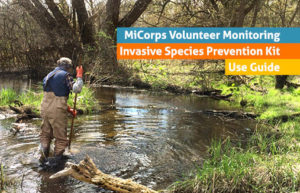
Consider building a decontamination kit and keeping it with your boat and gear. For ideas, see our tip cards and video.
YOU CAN HELP! VOLUNTEER.
Clean Boats Clean Waters is a cooperative program of Michigan Lake and Stream Associations and MSU Extension, training volunteers across Michigan to conduct boater education and boat/trailer inspections at boat launches to reduce the spread of invasive species.
Paws in Public Places
KEEP PET WASTE OUT OF OUR WATER.
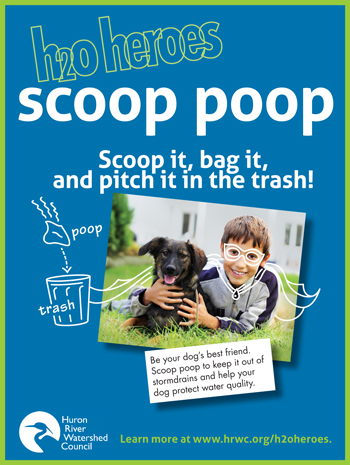
Be an example. Make your dog proud. When walking your dog(s) or visiting a park, scoop your pet’s poop, bag it, and pitch it in the trash every time!
Be Prepared. Carry disposable bags.
Handy tips from local dog owners:

- Carry extra bags to share with your friends.
- Buy bag “caddies” and attach them to all of your leashes.
- Keep bags in your coat pockets . . . the car . . . the garage . . . everywhere that might add convenience.
- Take a mini flashlight to help with nighttime pick-ups.
Work cooperatively.
Work with neighbors to install signs, bag dispensers and trash cans in pet-frequented areas in your neighborhood, reminding visitors to clean up. See how Chandler, AZ did it.
Spread the word.
Educate others about how stormwater can wash untreated pet waste right into our waterways. Think of friendly ways to start a conversation to tell others how they might change their behavior to help protect our rivers and streams. “Excuse me. Did you drop something?” “Oh, here, I have an extra baggie for you and your dog.” “Did you know…?”
What about kitty litter?

Kitty litter dumped outside can be washed into streams. When cleaning out the litter box, a 2-step approach is best. Cat waste may be scooped out and flushed down the toilet. The used kitty litter should be bagged and pitched in the trash.
It’s the law.
Most communities have local ordinances about pet waste pick up. Avoid fines. Report violators.
Stories and Resources
Pet stations for community parks: Chandler, AZ enlists local Eagle Scouts to construct low-cost refillable pet stations in community parks. See entire article.
The EPA’s Nonpoint Pollution Source Outreach Toolbox
Get Involved in Community Decisions
Get involved in community decision-making to preserve land and support smart-growth.
Learn how to use your voice to protect land and water in your township, city, or village
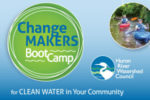 Become a Change Maker by joining one of our free Boot Camps. If you are interested in getting announcements for the next workshop, please sign up to get our Enews:
Become a Change Maker by joining one of our free Boot Camps. If you are interested in getting announcements for the next workshop, please sign up to get our Enews:
Urge your local board or council to adopt policies that:
- Encourage compact developments in areas with existing services like utilities, roads, and schools.
- Preserve natural areas and farmland.
- Learn how to raise funds for land conservation through a millage.
Participate in the master plan revision process.
Communities must revise their master plan every 5 years and are required by law to involve the public in that process.
Comment on possible zoning ordinance amendments.
Zoning ordinance amendments require time for public participation and comment. Many communities have established citizen groups that help them identify ordinances and ordinance amendments to improve their land use planning decisions. Offer to participate in or start such a group in your community.
Comment on specific developments during a site plan review session.
Voice concerns you may have about the development’s impact on wetlands and other natural features in your community. Encourage designs that use land efficiently and employ effective ways to treat water runoff.
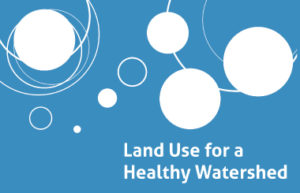 Read HRWC’s Citizen’s Guide To Land Use Planning, your guide to helping your community enact watershed-friendly practices.
Read HRWC’s Citizen’s Guide To Land Use Planning, your guide to helping your community enact watershed-friendly practices.
Learn more about the roles that various branches of government have regarding our home waters
The political and legal jurisdictions for the Huron River and its tributaries, riparian zones, and adjacent lands are controlled by federal and state laws, county and township ordinances, and town and village by-laws.
Federal and State
Regulatory and enforcement responsibilities for water quality often reside with the United States Environmental Protection Agency (EPA) and the Michigan Department of Natural Resources and Environment (MDNRE). The State of Michigan regulates major water resource management activities through the MDNRE – activities such as the alteration or loss of wetlands, stormwater control, the dredging or filling of surface water areas, and pollutant discharge.
Pollutant Discharge
Pollutant discharge, in particular, is regulated through NPDES (National Pollutant Discharge Elimination System) permits assigned by the MDNRE.
Phase II stormwater regulations have been issued by the United States Environmental Protection Agency (EPA) to comply with the Clean Water Act – legislation designed to clean up the nation’s waterways. Phase II regulations are specifically directed toward reducing the quantity and improving the quality of stormwater that is discharged into local rivers and waterways.
The Clean Water Act was passed in 1972 to prevent continuing degradation of the nation’s lakes, streams, and rivers. The Clean Water Act outlawed the discharge of pollution, encouraged the use of the best pollution control technology, and provided billions of dollars for the construction of sewage treatment plants. In 1987, the Act was amended to strengthen controls on toxic pollutants, and to allow the states to assume responsibility for federal programs. Under this amendment, the EPA in 1990 established Phase I of the National Pollutant Discharge Elimination System (NPDES), regulating all medium and large communities serving over 100,000 people.
In 1999, the EPA established Phase II regulations to reduce the impact of pollution resulting from increased residential and commercial development. Phase II requires permits for stormwater discharges from “municipal separate storm sewer systems,” known as MS4s. Such drainage systems may include roads, catch basins, curbs, gutters, parking lots, ditches, conduits, pumping devices, or man-made channels. Most of the local governments in the Huron River Watershed are required to have a Phase II permit.
In the State of Michigan, the MDNRE is administering the Phase II permit process. The EGLE prepares two kinds of EPA-approved permits: (1) a jurisdictional permit closely structured to adhere to the EPA’s minimum requirements for Phase II compliance, and (2) a watershed-based permit with requirements that are unique to Michigan. The watershed-based permit also meets the EPA’s minimum requirements for water pollution control, but maximizes flexibility and cost-sharing opportunities as well. Under the Phase II watershed-based approach, local governments and others holding permits work together to meet permit requirements.
Natural Rivers District
The State of Michigan Natural Rivers Program mandates certain development restrictions that are specific to the Huron River. The Huron River and its tributaries are public domain, and are subject to public trust protection. The 1970 Michigan Natural Rivers Act (Act 231) designated the stretch of river between Kent Lake Dam and Barton Pond (27.5 miles) as “country-scenic river.” This Natural Rivers District includes a protected zone of 400 feet on either side of the natural watermark. In this protected zone, development is strictly limited and the natural vegetation strip has been increased. On private lands within the District, zoning also requires extensive building structure and septic system set-backs on both the river’s main stem and the tributaries. In the Natural Rivers District of the Huron River, no new commercial, industrial, or extractive development is permitted within 300 feet of the river or its tributaries.
County
County governments assume responsibility for carrying out certain state policies. In most cases, county governments enforce the state’s erosion control policy under the Michigan Soil Erosion and Sedimentation Control Act 347 (1972), and Part 91 of Act 504 (2000). County road commissions typically are self-regulating in terms of erosion control, and local municipal governments may also administer this program.
The County Drain Commissioner’s Office is responsible for the operation and maintenance of stormwater management systems, also known as “county drains.” A watershed’s designated county drains may be open ditches, surface streams, underground pipes, retention ponds, or swales that convey stormwater. These systems are designed to provide stormwater management, drainage, flood prevention, and stream protection for urban and agricultural lands. The Drain Code gives the Drain Commissioner the authority to construct and maintain drains, creeks, rivers, watercourses, and their branches for flood control and water management. Drains that are not designated as county drains are maintained by the County Road Commission. These include roadside ditches, pipes, and culverts that pass under state highways and county roads.
In addition to oversight for drains, the County Drain Commissioner must maintain the established levels of lakes throughout the watershed. Under the 1961 Inland Lake Level Act (Act 146), the Drain Commissioner is responsible for having all lake-level control structures on inland lakes inspected every three years by a professional engineer. The Drain Commissioner is also responsible for assessing the costs of establishing and maintaining lake levels, and for filing petitions in circuit court to create a “special assessment district” to pay those costs.
City, Township, Village
Local government decisions about land use directly affect water resources and citizen participation is crucial for improving the decision-making process. Capital improvements and zoning ordinances together will define the future management and the future health of the Huron River’s corridors, floodplains, and wetlands.
In the state of Michigan, planning laws give local units of government substantial power to make decisions about land use. Local planning commissions, councils, and zoning boards create and implement zoning ordinances that regulate the “what” and “where” of commercial and residential development. The decision-making process typically takes place in a series of meetings that are open to the public.
A planning commission is a group of officials appointed by a village, township, or city council. The commission’s primary duties include proposing, developing and amending zoning ordinances, as well as creating and updating a development master plan. The planning commission’s role is largely advisory. Planning commissions have no legislative power.
A village, township or city council or board is a group of officials elected to office by citizens of the community. Municipal councils appoint planning commissioners, and authorize funds for studies of water resources and water quality. Councils do have legislative power. They can approve or deny planning commission proposals, and they can enact ordinances.
Zoning boards interpret the provisions of zoning ordinances. Zoning boards frequently serve as “boards of appeal,” hearing petitions from planning commissions and private citizens. Zoning board members are appointed, usually by councils, and their role as arbiters is critical to the decision-making process.
Local governments assume leadership in land and water management by passing and enforcing safeguards that are often more protective than state laws. Using established procedures, local governments enact ordinances to control stormwater runoff, soil erosion, and sedimentation, and to protect sensitive habitats such as woodlands and wetlands. Local governments also establish watershed-friendly development standards, and lawn care and landscaping practices, while at the same time enforcing legislated policy.
Each local government in the Huron River Watershed holds regularly scheduled meetings where rulings are made on additions and changes to policy, on budgets, land-use issues, and other important items of local business. Often working with statewide guidelines and procedures, local governments can formulate policy for the use and development of the land within their jurisdictions.
Pitch in with a DIY Cleanup You can do one on land, water, or shoreline. It's easy! We'll show you how.
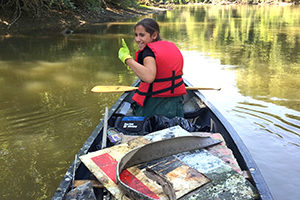 If you’re out boating on the river and see trash, please remove it and put it in trash/recycling bin when you get to shore. Always be careful to avoid damaging the riverbanks and vegetation.
If you’re out boating on the river and see trash, please remove it and put it in trash/recycling bin when you get to shore. Always be careful to avoid damaging the riverbanks and vegetation.
You can also remove litter and debris (like leaves) from the streets too; they end up in the river when they wash down the stormdrains. Every little bit helps!




